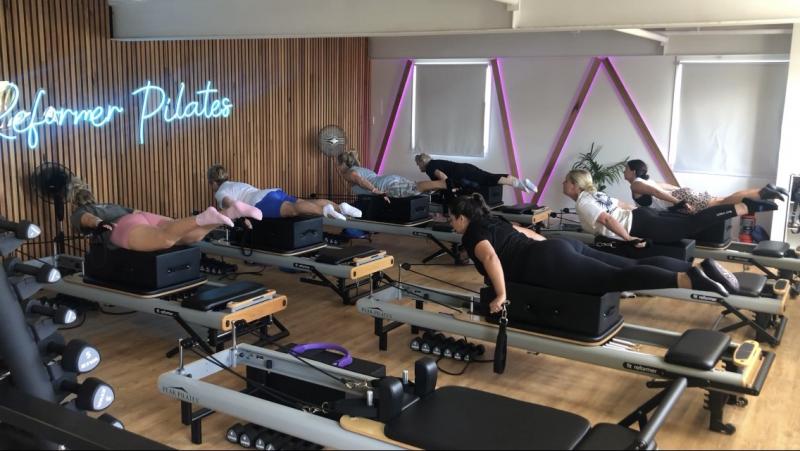Tips To Help You Get The Most Out Of Your Reformer Pilates Class

“The manner in which the exercises are performed is of far greater importance than the number of repetitions or exertion applied to the movements. Quality is superior to quantity.” ~ Alan Menezes.
Following are four tips to make the most out of every movement to reap the benefits.
1. Slow down: Moving slower is significantly more challenging than just going through the motions in a rushed state. [1]
So, what are the benefits of moving slowly:
a) Moving slowly enables us to have a deeper mind-body connection, it allows your brain to focus on form and breath in the correct way.
”Concentrate on the correct movements each time you exercise, lest you do them improperly and thus lose all the vital benefits of their value.” ~ Joseph Pilates.
b) Moving slower actually increases the spring tension, making you work harder without increasing the springs! This is due to decreasing momentum which allows you to always have the same intensity of the spring tension throughout the full movement. For example: an exercise may require you to hold the straps (light spring used) and pull with the hands, if you pull with too much force and too quickly, you’ll lose the spring tension completely. Whereas if you pull with more control and at a slower pace, the spring tension will remain the same throughout the movement. Or, using dumbbells, you may have heard your instructor cue you to slow down and use muscle control not momentum to work efficiently.
An exception to moving slowly would be when specifically asked to move faster eg. pulses or during our Genesis Cardio Block (signature designated cardio blast before our Cool Down) .
If they don’t specify the pace, assume that you need to be moving slowly. Moving at a slower, controlled pace will provide the most benefits for your body in reformer classes. [2].
2. Breath: a great way to help determine your pace is noticing how you breathe during the movement. Breathing is one of Eight Principles of the Pilates Method. As a rule of thumb (for beginners and in the gym environment), you breath out (exhale) at the hardest part of the movement, and breath in (inhale) at the easier part of the movement, unless the instructor cues otherwise.
Did you know that deep slow breathing not just walking, jogging and other aerobic exercise are key to heart health? YES… deep breathing! Deep slow breaths can also improve your circulation, lower blood pressure, improve quality of your air ways enhance your mental outlook, strengthen your bones and calm us down!
Esther Sternberg (physician, author and researcher at the National Institute of Mental Health) says, ” …rapid breathing is controlled by the sympathetic nervous system. It's part of the fight or flight response, the part activated by stress”. In contrast, slow, deep breathing stimulates the opposing parasympathetic reaction, the one that calms us down.
“Before any real benefit can be derived from physical exercises, one must first learn how to breath properly.” ~ Joseph Pilates.
3. Springs: there are many different spring options given throughout a reformer class, at Genesis we generally give you two options per exercise which the instructor may cue as ‘a beginner or advanced option’ or ‘an easier or more challenging option’. Using a stronger spring doesn’t always mean it is the harder option. In fact, loading the springs can have the opposite effect by switching off the deep core muscles and making the outer, superficial muscles do all the work, which is not the Pilates aim.
While using springs during an exercise you should feel your deep core engaged throughout the entire class. Even if the exercise is for your limbs, your core should be engaged and provide support for the whole body. If you can’t switch on your deep core, the spring tension may not be appropriate, if this is the case check in with your instructor.
4. Repetitions: The manner in which the exercises are performed is of far greater importance than the number of repetitions or exertion applied to the movements. Quality is superior to quantity. [3]
Sometimes, you may be able to complete 8-12 reps (depending on the movement) before feeling a little fatigued, other times only reach 4-6 and you feel your muscles shaking, this may be due to the incorrect spring used or a weak muscle due to injury, compensation etc. If using hands straps, you may be able to switch to the longer straps with minimum fuss or check in with the instructor about your spring choice. Having the correct spring level can make a big difference as can reducing repetitions, favouring quality of motion over quantity and practicing patience and persistence.
“Patience and persistence are vital qualities in the ultimate successful accomplishment of any worthwhile endeavor.” ~ Joseph Pilates
So, the tips above should give you the tools and knowledge to work in a more productive manner rather than working faster and performing more repetitions in the guise of working efficiently! Remember that Pilates comes from a mind/body, rehab background and concentration, core, breathing, precision and mobility are key foundations of every exercise.
Notes:
1 & 2. How to Enhance Your Reformer Workout by Premium Pilates & Fitness.
3. The Complete Guide to the Pilates Method by Alan Menezes.
Article by Martine Ford.




